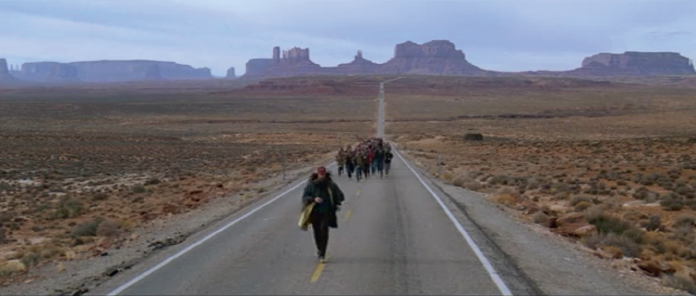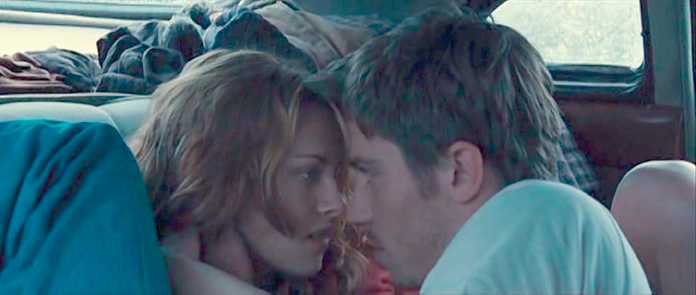Development
It’s extremely rare for a first-draft screenplay to be ready to shoot; in fact, in your authors’ collective careers, which span hundreds of movies, it has happened exactly once, and even then, the writer did revisions to attract casting and to customize the script to budget and location demands. Rather, scripts are written and rewritten, with input from constructive readers, directors, actors, and producers; this process is called development. The purpose of development is to refine the script so that it represents as precisely as possible the plan for shooting; even with a class project, good script development is the most essential element for ensuring a good movie.
 LOOK FOR WHITE SPACE
LOOK FOR WHITE SPACE
After you have finished your draft, look at it on page view. If you don’t see a lot of white space, you have overwritten. Often times a writer may add white space to emphasize a key moment in the screenplay.
Developing Your Script
There are three great reasons to develop your script through several revisions to get it as polished as possible and to take development seriously. First, even though writing is hard, it requires far fewer resources than does shooting or editing. It is much cheaper—
Second, a bad script never makes a good movie. Most films that fall short of excellence do so because their scripts were not good enough in the first place and did not go through sufficient independent scrutiny and feedback. Therefore, even if you are working on a project for yourself to direct (and produce and star in and write the songs for), you need to create a process for personal development to make your screenplay excellent. Such a process involves trusted friends and advisers who have experience reading scripts and commenting on them, who can be encouraging and give honest feedback, and who can be relied on to tell you the truth even when it is painful. Good writers are always helped by sensitive readers’ responses, and all writing involves rewriting. (See How Do I... Respond to Script Notes?)
The third reason development needs to be taken seriously is because it involves business matters and intellectual property rights. Unfortunately, many first-
The Studio Development Cycle
Film studios have a much more formal and rigorous development process than you’ll follow in class—a process that not only offers some perspective on what happens when millions of dollars are at stake, but also expands on why intellectual property rights, which you learned about earlier, are so important. Studios begin with a legal process of getting rights. Often, they will purchase, or option, the intellectual property rights in a given work (screenplays written independently, video games, or any other kind of intellectual property), which means the studio will pay a certain amount of money for the right to develop that project for a given period of time. When that time is up, the studio must either purchase the rights—in which case the studio will own the rights forever—or let the option go, in which case the rights will revert, or go back, to the original owner. This process is formally known as having your project put into turn-around.
A Writer’s Contract

If you’re going to write for or with someone else, you need to have a contract—a written legal document that clearly explains what everyone has agreed to. Seek competent legal advice on any contract before you sign it, especially if it is a professional screenwriting contract, which usually runs 30 or more pages long and contains rather sophisticated provisions.
Following are some common points a contract will include:
 If you are writing with someone else (a writing partner). Who owns the material? If someone buys it, how will the money be split? How will writing credit be determined? If you come to a creative parting of ways in the future, what happens?
If you are writing with someone else (a writing partner). Who owns the material? If someone buys it, how will the money be split? How will writing credit be determined? If you come to a creative parting of ways in the future, what happens? An option (an agreement to purchase something in the future). For example, in independent films, a producer might option a script for one dollar for 12 months. (Producers and studios may option material for much more money, too.) That would mean the producer pays the writer one dollar and has the right to buy the screenplay sometime during the next 12 months. An option must specify the time period and the purchase price. Sometimes, options have a renewal built in, which means the option period can be extended for a pre-agreed-to time for a pre-agreed-to price.
An option (an agreement to purchase something in the future). For example, in independent films, a producer might option a script for one dollar for 12 months. (Producers and studios may option material for much more money, too.) That would mean the producer pays the writer one dollar and has the right to buy the screenplay sometime during the next 12 months. An option must specify the time period and the purchase price. Sometimes, options have a renewal built in, which means the option period can be extended for a pre-agreed-to time for a pre-agreed-to price. Purchase price (what the writer will be paid to sell rights to the script). The purchase price typically consists of immediate cash plus back-end money, or a percentage of future profits, if any. Note that most films don’t make a profit.
Purchase price (what the writer will be paid to sell rights to the script). The purchase price typically consists of immediate cash plus back-end money, or a percentage of future profits, if any. Note that most films don’t make a profit. What happens if the movie isn’t made? Do you get the project back? After what period of time? Would you have to repay some or all of the money in order to get your project back?
What happens if the movie isn’t made? Do you get the project back? After what period of time? Would you have to repay some or all of the money in order to get your project back? Writing steps. If a writer is hired on an open assignment, the writer will be contracted for one or more writing steps. These steps may be a first draft, a revision, or a polish—levels of work defined by the Writers Guild. The writer will be paid some money on commencement of each step (at the start of writing) and the balance on delivery of the final step (when the script is turned in).
Writing steps. If a writer is hired on an open assignment, the writer will be contracted for one or more writing steps. These steps may be a first draft, a revision, or a polish—levels of work defined by the Writers Guild. The writer will be paid some money on commencement of each step (at the start of writing) and the balance on delivery of the final step (when the script is turned in). Credit. If you are working on a non–Writers Guild movie, your contract should specify your writing credit and how you want to be credited on-screen, in posters, or in advertisements. Typically, the writer’s credit is placed immediately before the director’s credit, and the writer’s contract will specify that the writer’s name must be the same size, boldness, and typeface as the names of other people getting credit. If the Writers Guild is governing the project, it has the sole power to determine writing credit; the producers or the studio have no say in the matter.
Credit. If you are working on a non–Writers Guild movie, your contract should specify your writing credit and how you want to be credited on-screen, in posters, or in advertisements. Typically, the writer’s credit is placed immediately before the director’s credit, and the writer’s contract will specify that the writer’s name must be the same size, boldness, and typeface as the names of other people getting credit. If the Writers Guild is governing the project, it has the sole power to determine writing credit; the producers or the studio have no say in the matter. Rights. You’ll need to state that the work is entirely your original creation—that you own the work—or, if the work is an adaptation, that you have been given the rights to the underlying work. If your script is purchased, you will be selling all of your rights unless you negotiate to retain some rights. Writers are sometimes able to retain certain rights, such as novelization or live-stage rights, but this is uncommon.
Rights. You’ll need to state that the work is entirely your original creation—that you own the work—or, if the work is an adaptation, that you have been given the rights to the underlying work. If your script is purchased, you will be selling all of your rights unless you negotiate to retain some rights. Writers are sometimes able to retain certain rights, such as novelization or live-stage rights, but this is uncommon. Sequels and remakes. Your contract may address whether or not you need to be offered the first crack at writing any projects based on your original work and if you will have any share in the profits from those projects regardless of your writing involvement. This stipulation is very important if your script ultimately becomes the basis for a hit studio franchise.
Sequels and remakes. Your contract may address whether or not you need to be offered the first crack at writing any projects based on your original work and if you will have any share in the profits from those projects regardless of your writing involvement. This stipulation is very important if your script ultimately becomes the basis for a hit studio franchise.
Sometimes studios acquire rights to a story based on the writer’s pitch. A pitch is a meeting in which the writer tells the film’s story. The pitch generally has two forms—short and long. A short pitch, which may be given over the phone by the writer’s agent or a producer, is two to three minutes and is enough to determine if there is interest. The long pitch, given in person by the writer, is 15 to 20 minutes and gives the whole story of the film. Although few projects sold as pitches ever get made into finished movies, studios still buy them occasionally, especially from established writers with whom the studio has a preexisting relationship, or if it is based on a recent, major worldwide event.
Another way studios obtain rights to a story is through script submissions, but these kinds of submissions can be tricky, as studios are often faced with lawsuits from people who believe the studios stole their idea. Studios will not even look at unsolicited submissions; you will get your screenplay back in the original sealed envelope that you sent it in, with a formal letter stating the studio’s policy of not accepting unsolicited submissions. To give themselves some protection, studios accept script submissions only from recognized entertainment agents or attorneys, because these legally authorized writers’ representatives understand the industry’s business practices—especially the fact that many projects are similar to many other projects—and will counsel writers not to pursue unfounded plagiarism claims.
 WRITE FOR MOVIES, PITCH FOR TV
WRITE FOR MOVIES, PITCH FOR TV
Most successful studio movies are based on source material or scripts written independently by writers; very few start as pitches. In contrast, most television series start as pitches.
Even though studios restrict the ways they receive new material, they still face the daunting process of evaluating the 25,000 projects that are submitted to them each year. Because the volume of submitted screenplays is so large, studios employ teams of executives whose initial task is to determine whether each project is commercial and meets the studio’s needs. These executives are assisted by story analysts, who read the projects and write coverage: a brief summary and commentary on each project. When executives decline a project, they say they are “passing” on it. The vast majority of scripts are rejected, both because of the sheer volume of them and because to say yes to a project entails a considerable commitment of time and finances.
If the executives believe the project should be acquired by the studio, they will pitch the project to upper management. If management concurs and a business arrangement or deal can be made, generally with a writer’s agent or attorney, the studio will put the project into development; all studio business deals with writers are governed by the studios’ contract with the Writers Guild. Each studio has between 100 and 200 projects in active development, and another two to three hundred projects that are inactive, or “on the shelf.”
Studio development involves a close collaboration between the writer and the executives developing the project. Generally, there is an initial meeting during which the writer pitches a vision for writing or revising the project, and several meetings may follow in which the characters and story are discussed in greater detail. The executive may consult with upper studio management in an effort to ensure that the project’s direction will ultimately be to their liking. (See Producer Smarts: How to Work with the Writer, below.)
When the writer turns in a draft of the script, the studio executives read it and decide if they are going to continue with the project and, if so, whether they will continue with the same writer. If the answer to both questions is yes, the executives will prepare studio notes, which provide a road map for the writer to follow in a script revision.
The studio may also decide to replace the writer, an event that happens frequently—especially on most films that eventually get made. In this case, the first writer’s contract is terminated, and the project becomes an open assignment, meaning that the assignment is open for a new writer to work on it.
The studio may also decide to abandon the project entirely. Because studios have many projects in development even though they only make about 20 films per year, more than 80 percent of development projects are eventually abandoned. The average time a project is in development until it is either abandoned or given a green light (formally committed to production) is three years. Some projects move much more quickly, whereas others have been in development for 20 years or more before getting made. For this reason, studio development is often called “development hell” by writers, producers, and executives alike, with a knowing sense of irony about the arbitrary and lengthy nature of the process. On the other hand, it is a process that works best for the studios because it gives them security to know that a very large budget movie will have a script that the senior executives at the studio like.
 SHORT PITCHING
SHORT PITCHING
This group exercise is best done with at least four people. Each of you should come up with a three-minute pitch for a full-length feature you might make one day. Then, for each pitch, the group should give reactions and notes on how to make it better. This process is a good model for what writers actually go through in studio notes/development sessions.

Forrest Gump (1996)
Forrest Gump was in development for nine years before it got made. Although that may seem like a long time, On the Road, the film adaptation of Jack Kerouac’s landmark novel, was in development for more than 30 years.

On the Road (2012)
How to Work with the Writer

Producers play a crucial role in shaping screenplays, even if they may not write any of the words themselves. That’s because producers often find and hire writers, and take the lead in giving notes to steer the development process. As a producer, when you’re working with a writer, follow these constructive practices:
 Before writing commences, review the outline and offer feedback. The writer will be grateful if you can help ensure that the structure is sound.
Before writing commences, review the outline and offer feedback. The writer will be grateful if you can help ensure that the structure is sound. Offer to read scenes and give comments while the script is being written if the writer wants that kind of feedback.
Offer to read scenes and give comments while the script is being written if the writer wants that kind of feedback. When the draft comes in, read it carefully and make notes. Pay attention to character, dialogue, plot, story structure, theme, rhythm, and flow, and also to whether the writer has called for any scenes that are beyond your project’s budget or will be difficult to shoot. Then, meet with the writer to discuss the script and possible revisions. Always start with compliments and stress what is working well before delving into areas that need improvement.
When the draft comes in, read it carefully and make notes. Pay attention to character, dialogue, plot, story structure, theme, rhythm, and flow, and also to whether the writer has called for any scenes that are beyond your project’s budget or will be difficult to shoot. Then, meet with the writer to discuss the script and possible revisions. Always start with compliments and stress what is working well before delving into areas that need improvement. Afterward, it’s helpful to follow up with a written memo summarizing the conversation and what the writer will do next. It is hard for writers to remember everything that is said during a development meeting; they’re often focused on defending their first draft. The written memo will help them stay on course and remember what revisions they need to accomplish.
Afterward, it’s helpful to follow up with a written memo summarizing the conversation and what the writer will do next. It is hard for writers to remember everything that is said during a development meeting; they’re often focused on defending their first draft. The written memo will help them stay on course and remember what revisions they need to accomplish.
If the director has already been selected, make sure to include him or her in these steps, too.
Writer’s Emergency Kit

 Pen and notepad, to record ideas as they occur and great bits of dialogue you hear in conversations, and an audio recording app for your mobile device to record meetings and thoughts on the fly
Pen and notepad, to record ideas as they occur and great bits of dialogue you hear in conversations, and an audio recording app for your mobile device to record meetings and thoughts on the fly A willingness to put your emotions and viewpoints out for public display
A willingness to put your emotions and viewpoints out for public display A library card
A library card Screenplay software, and a way to back up your work with a hard drive or cloud-based storage
Screenplay software, and a way to back up your work with a hard drive or cloud-based storage Writing itself. When everything falls apart, the thing you can always fall back on is your craft. No one can take that away from you
Writing itself. When everything falls apart, the thing you can always fall back on is your craft. No one can take that away from you